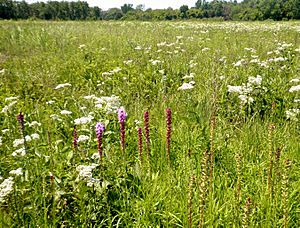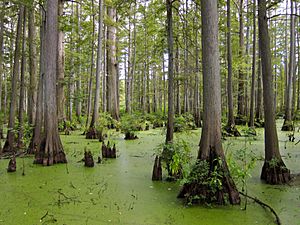List of National Natural Landmarks in Illinois facts for kids
Illinois is home to 18 amazing places called National Natural Landmarks (NNLs). These are like nature's treasures! There are almost 600 of these landmarks across the entire United States. They protect important areas like lakes, bogs, canyons, and forests. These spots are special because of their geology (how the land is formed), biology (the plants and animals), and even history.
Many of these landmarks are safe homes for rare or endangered plants and animals. You can find them in 13 of Illinois's 102 counties. Some counties even have more than one NNL! The first one, Forest of the Wabash, was named in 1965. The newest, Markham Prairie, joined the list in 1987. These natural landmarks in Illinois vary in size, from about 53 acres to a huge 6,500 acres. They are owned by different groups, including private people, organizations, and government agencies.
Contents
- What are National Natural Landmarks?
- Illinois' Amazing Natural Landmarks
- Allerton Natural Area
- Bell Smith Springs
- Busse Forest Nature Preserve
- Forest of the Wabash
- Fults Hill Prairie Nature Preserve
- Funks Grove Nature Preserve
- Giant City Geological Area
- Heron Pond - Little Black Slough Nature Preserve
- Horseshoe Lake
- Illinois Beach Nature Preserve
- LaRue-Pine Hills Ecological Area
- Little Grand Canyon
- Lower Cache River Swamp
- Lusk Creek Canyon
- Markham Prairie
- Mississippi Palisades
- Volo Bog Nature Preserve
- Wauconda Bog Nature Preserve
- See also
What are National Natural Landmarks?
The National Park Service helps manage the National Natural Landmarks Program. This is a part of the Department of the Interior, which looks after America's natural resources. The National Park Service decides which places are special enough to become NNLs. They talk to the owners and then suggest the best spots.
The Secretary of the Interior then makes the final decision. Both public and private lands can become NNLs. Owners can say no if they don't want their land to be a landmark. Being an NNL helps protect these places. It can offer tax benefits or grants to help keep them safe and beautiful for the future.
Illinois' Amazing Natural Landmarks
Illinois has many unique natural areas. Here are some of the special places designated as National Natural Landmarks:
Allerton Natural Area
Designated in 1970, the Allerton Natural Area is in Piatt County. It's a rare example of Illinois's stream valley ecosystems. You can see forests along the river and on higher ground that haven't been disturbed much. It's part of the larger Robert Allerton Park.
Bell Smith Springs
Named in 1980, Bell Smith Springs is in Pope County. It's part of the Shawnee National Forest. This area shows amazing sandstone formations that have been shaped by streams and landslides. It's a great place to see how natural forces change the land.
Busse Forest Nature Preserve
Also designated in 1980, Busse Forest Nature Preserve is in Cook County. This historic preserve has beautiful forests on both moist and drier uplands. It's one of the best examples of its kind in the central lowlands region. It's part of the Cook County Forest Preserve District.
Forest of the Wabash
Designated in 1965, the Forest of the Wabash is in Wabash County. This site is part of Beall Woods State Park. It features untouched forests along the Wabash River. These include a major example of the remaining oak-hickory forests in the area.
Fults Hill Prairie Nature Preserve
Named in 1986, Fults Hill Prairie Nature Preserve is in Monroe County. This prairie is the best and most untouched example of "loess" hill prairies in the region. Loess is a type of soil deposited by wind.
Funks Grove Nature Preserve
Designated in 1974, Funks Grove Nature Preserve is in McLean County. It's a special place where oak-hickory forests meet other types of eastern forests. It's a rare example of the original, untouched forests in the area.
Giant City Geological Area
Named in 1980, the Giant City Geological Area is in Union County. It's part of Giant City State Park. This area has huge sandstone blocks from the Pennsylvanian age. You can see how gravity has caused them to slide. It also has many plants, including sugar maple forests and oak-hickory woodlands.
Heron Pond - Little Black Slough Nature Preserve
Designated in 1972, Heron Pond - Little Black Slough Nature Preserve is in Johnson County. This is the largest remaining cypress-tupelo swamp in Illinois. It has different types of soil deposits and is home to a heron rookery, where herons build their nests.
Horseshoe Lake
Also named in 1972, Horseshoe Lake is in Alexander County. This lake is home to many plants, including mature bald cypress trees. It's also a vital spot for animals, especially migrating waterfowl and Canada geese that spend the winter there. It's part of Horseshoe Lake State Fish and Wildlife Area.
Illinois Beach Nature Preserve
Designated in 1980, Illinois Beach Nature Preserve is in Lake County. This site is part of Illinois Beach State Park. It has a wide variety of ecosystems, including savannas, prairies, wetlands, and beaches. Many endangered species live here.
LaRue-Pine Hills Ecological Area
Named in 1974, LaRue-Pine Hills Ecological Area is in Union County. It's part of the Shawnee National Forest. This area provides a home for many different plants, including 40 rare species from all over Illinois.
Little Grand Canyon
Designated in 1980, Little Grand Canyon is in Jackson County. This is a large box canyon with tall, overhanging walls. It has many different ecosystems, including sandstone areas, oak-hickory forests, and prairies. It's famous for the many types of snakes that hibernate there. It's located in Shawnee National Forest.
Lower Cache River Swamp
Named in 1980, the Lower Cache River Swamp is in Johnson and Pulaski counties. This swamp is a small piece of a much larger ecosystem that once existed. It's home to huge trees, including three that are record-holders for their species!
Lusk Creek Canyon
Designated in 1980, Lusk Creek Canyon is in Pope County. It's part of the Shawnee National Forest. This canyon was formed by streams and landslides cutting through sandstone. It has two main forest ecosystems and many endangered plant species.
Markham Prairie
Named in 1987, Markham Prairie is in Cook County. This is the largest high-quality, untouched prairie in Illinois and one of the biggest in the region. It's a remaining piece of a prairie ecosystem that used to cover a much larger area. It has a mix of sand prairie and tallgrass prairie, plus an undeveloped lakebed and old beach ridges.
Mississippi Palisades
Designated in 1972, Mississippi Palisades is in Carroll County. This area has cliffs, caves, and valleys that show off its unique "palisades" landscape. It also provides a home for many animals and plants. It's located in the state park with the same name.
Volo Bog Nature Preserve
Also named in 1972, Volo Bog Nature Preserve is in Lake County. This is a classic example of a "quaking bog" from the northern parts of the state. It's a special habitat for many unusual and rare plant species.
Wauconda Bog Nature Preserve
Designated in 1972, Wauconda Bog Nature Preserve is in Lake County. This is the southernmost example of a mature bog in Illinois. It has a unique group of plants and animals that are not commonly found in this region.
See also
- List of ecoregions in Illinois
- Illinois Natural History Survey


















